The advent of 5G New Radio (NR) technology marks a transformative milestone in the evolution of telecommunications, unlocking unprecedented opportunities for diverse industries and applications. With features like ultra-reliable low-latency communication (URLLC), massive Internet of Things (mIoT), and network slicing, 5G NR is poised to reshape industries such as manufacturing, healthcare, and logistics under the banner of Industry 4.0.
This article delves into the critical role of 5G NR in these emerging domains, focusing on how network slicing enhances service delivery for tailored use cases.
1. The Foundation: 5G NR and Its Core Features
5G NR represents a significant leap in wireless communication, designed to address the limitations of its predecessors (LTE and LTE-A). Its distinguishing features include:
- Enhanced Mobile Broadband (eMBB): High-speed data rates for applications like augmented reality (AR) and high-definition video streaming.
- URLLC: Ensures ultra-reliable, low-latency connections for mission-critical applications, such as remote surgery and autonomous vehicles.
- mIoT: Connects billions of low-power devices, enabling smart cities and industrial automation.
- Network Slicing: The ability to create multiple virtual networks on a single physical infrastructure, each optimized for specific use cases.
These capabilities form the backbone of 5G’s ability to support emerging applications across various industries.
2. Industry 4.0: The Role of 5G NR
Industry 4.0 signifies the integration of advanced technologies like IoT, AI, and robotics into manufacturing and industrial processes. 5G NR serves as a critical enabler for this transformation by providing:
- Seamless Connectivity: High-speed and reliable connections for real-time data exchange between machines and systems.
- Remote Operation: Enabling remote monitoring and control of machinery in hazardous or inaccessible environments.
- Predictive Maintenance: Leveraging IoT sensors connected via 5G to monitor equipment health and predict failures, reducing downtime.
For example, in a smart factory, robots can coordinate tasks with near-zero latency, boosting efficiency and productivity.
3. Ultra-Reliable Low-Latency Communication (URLLC)
URLLC is a cornerstone of 5G NR, catering to applications that demand near-instantaneous response times. Key use cases include:
- Autonomous Vehicles: Real-time communication between vehicles, infrastructure, and pedestrians to ensure safety.
- Healthcare: Remote surgery and telemedicine applications that require minimal latency to ensure precision.
- Industrial Automation: Coordinating robotics and control systems in manufacturing processes with millisecond-level latency.
The URLLC framework guarantees stringent Quality of Service (QoS) requirements, making it indispensable for mission-critical tasks.
4. Massive IoT (mIoT) and Smart Ecosystems
The proliferation of IoT devices necessitates a network capable of connecting billions of devices simultaneously. 5G NR’s mIoT capabilities include:
- Scalability: Accommodates a vast number of devices, from sensors in agriculture to smart home appliances.
- Energy Efficiency: Optimized power consumption ensures longer battery life for IoT devices.
- Wide Coverage: Reliable connectivity in urban, suburban, and rural environments.
Smart cities are a prime example, where 5G NR supports applications like intelligent traffic management, waste monitoring, and public safety systems.
5. Network Slicing: Tailored Service Delivery
Network slicing is a revolutionary feature of 5G NR, allowing operators to allocate virtualized network resources for specific use cases. Each slice operates independently, ensuring customized performance metrics such as latency, bandwidth, and reliability.
Applications of Network Slicing:
- Enhanced Mobile Broadband Slice:
- For AR/VR applications, high-bandwidth slices deliver immersive experiences.
- URLLC Slice:
- Dedicated to critical applications like autonomous driving or factory automation, ensuring ultra-low latency and reliability.
- mIoT Slice:
- Supports large-scale IoT deployments with optimized power and capacity.
Example: Smart Port Operations
In a smart port, network slicing can simultaneously support:
- High-speed internet for administrative tasks.
- Low-latency connectivity for autonomous cranes.
- IoT connectivity for real-time cargo tracking.
This ensures efficient and uninterrupted operations across diverse port activities.
6. Challenges and Considerations
While 5G NR is revolutionary, it is not without challenges:
- Infrastructure Costs: Deploying 5G requires significant investment in base stations, small cells, and core networks.
- Interoperability: Ensuring seamless integration with legacy networks and devices is critical.
- Security: Enhanced connectivity and IoT adoption introduce new cybersecurity risks.
These challenges require strategic planning and innovation to fully realize the potential of 5G NR.
7. Future Outlook: Beyond 5G
The journey doesn’t end with 5G NR. Research into 6G promises even greater advancements, such as:
- Terahertz communication for ultra-high-speed data transfer.
- AI-driven network optimization for predictive and autonomous operations.
- Further enhancements in network slicing for more granular customization.
These developments will continue to build on the foundation laid by 5G NR.
Conclusion
5G NR is more than just a step forward in mobile communication; it is a catalyst for innovation across industries. By enabling applications like Industry 4.0, URLLC, IoT, and network slicing, it paves the way for smarter, more connected ecosystems. Despite its challenges, the technology’s potential to transform industries and improve quality of life makes it a cornerstone of the digital future.
As 5G deployments expand globally, the focus will shift from implementation to innovation, unlocking possibilities that were once unimaginable.
You Might Also Like







